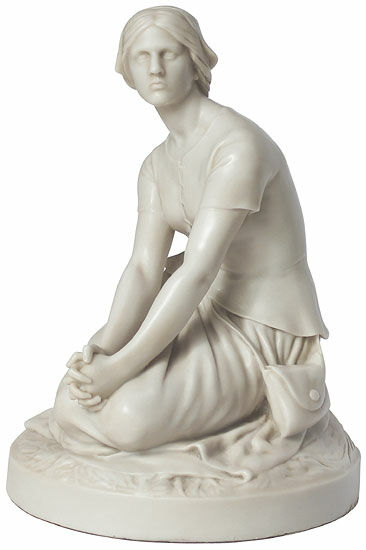Sculpture "Joan of Arc" (c. 1880), cast stone version
Sculpture "Joan of Arc" (c. 1880), cast stone version
Quick info
ars mundi Exclusive Edition | limited, 299 copies | numbered | signed | edition in cast stone | patinated | polished | Ø 20.5 cm | height 28.5 cm | weight approx. 4.5 kg
Detailed description
Sculpture "Joan of Arc" (c. 1880), cast stone version
She sits with hands folded, calm - tenderly and confidently gazing into the distance. Joan of Arc (1412-1431) was accused by the Inquisition and executed in adverse circumstances, but she became a French myth. In 1920, she was canonised by the Catholic Church.
Original: Marble, Musée d'Orsay, Paris.
Edition in cast stone. Cast by hand, patinated and polished. Limited edition of 299 copies, numbered and signed. Size 20.5 x 28.5 x 20.5 cm (w/h/d). Weight approx. 4.5 kg. Exclusively at ars mundi.
About Henri Michel Chapu
1833-1891
The French sculptor and metal artist made his debut at the age of 22 at a major exhibition at the Paris Salon in 1855. Chapu was so convincing there that one of his works was awarded the "Prix de Rome" by the Rome Academy of Art. This also included a scholarship of several years in the Italian capital.
He was inspired by themes from ancient mythology and combined them with the typical naturalistic style of that time. In this way, his figures experience an idealistic elevation, as does the famous "Statue of the Cantata", which adorns the main entrance of the Opéra de Paris. Chapu's sensitive works were popular. He received many commissions for public spaces. Among others, the statue of the jurist Pierre-Antoine Berryer for the Paris Palace of Justice was his creation.
Graphic or sculpture edition that was initiated by ars mundi and is available only at ars mundi or at distribution partners licensed by ars mundi.
Collective term for all casting processes that ars mundi carries out with the help of specialised art foundries.
Stone casting
Similar to artificial marble, with the difference that the substitute stone in powder form is used instead of marble powder.
Bonded Bronze (Cold-Cast-Bronze)
Bronze powder is polymer-bonded. Special polishing and patination techniques give the surface of the casting an appearance similar to the bronze.
Imitation Wood
In order to guarantee absolute fidelity to the original, an artificially manufactured imitation wood is used as a base material that features typical wood characteristics: density, workability, colour and surface structure.
Ceramic Mould Casting
Ceramic mould casting usually requires the use of casting clay, which is then fired and optionally glazed. Instead of the usual rubber moulds, plaster moulds are often used in ceramic casting and porcelain production.
Cast Bronze (Lost-Wax Casting)
For the cast bronze, the thousand-year-old lost-wax technique is used. It's the best, but also the most complex method of producing sculptures.
Term for an art object (sculpture, installation), which is produced in multiple copies in a limited and numbered edition according to the artist‘s will.
Artist's multiples have been called the most accessible and affordable art on the market.
A plastic work of sculptural art made of wood, stone, ivory, bronze or other metals.
While sculptures from wood, ivory or stone are made directly from the block of material, in bronze casting a working model is prepared at first. Usually, it is made of clay or other easily mouldable materials.
The prime time of sculpture after the Greek and Roman antiquity was the Renaissance. Impressionism gave a new impulse to the sculptural arts. Contemporary artists such as Jorg Immendorf, Andora, and Markus Lupertz also enriched sculptures with outstanding works.









